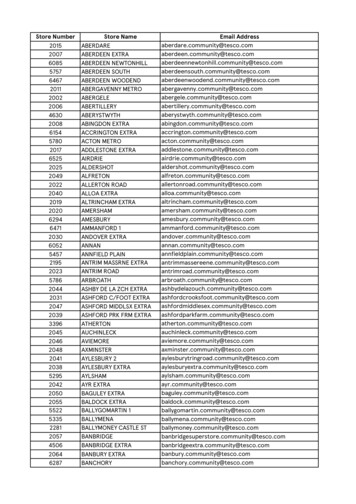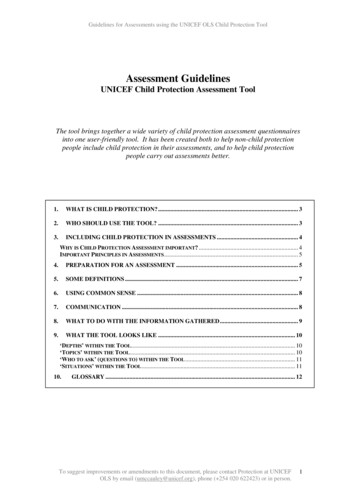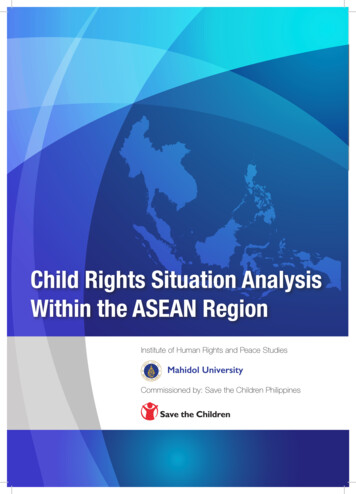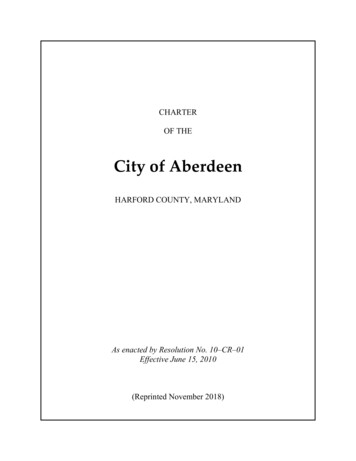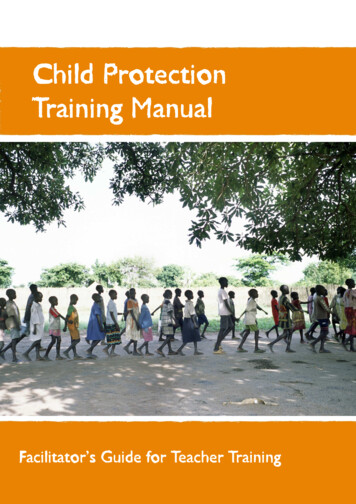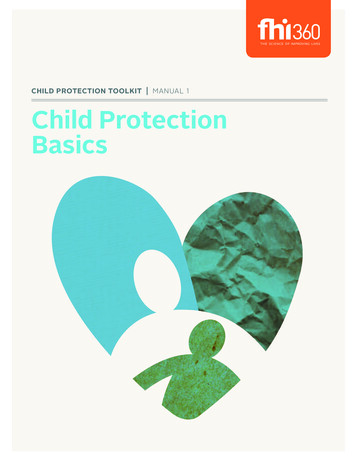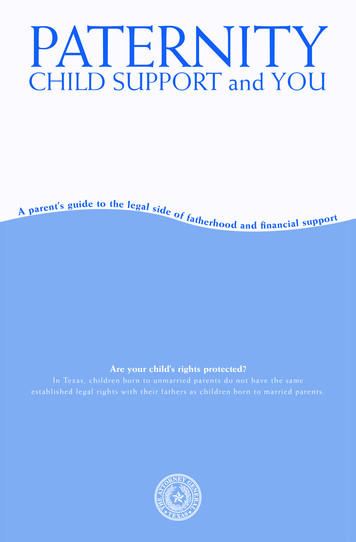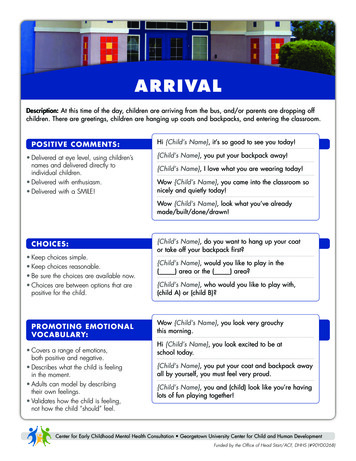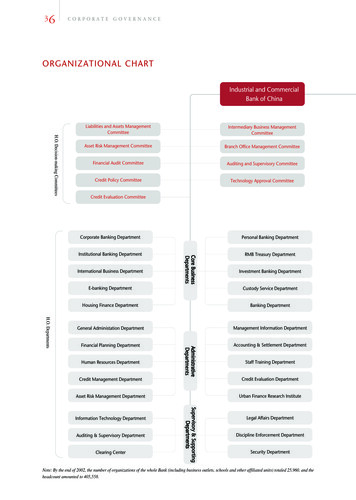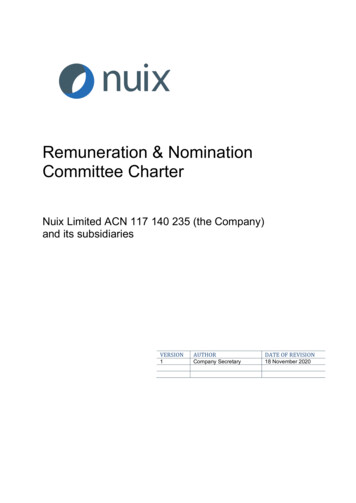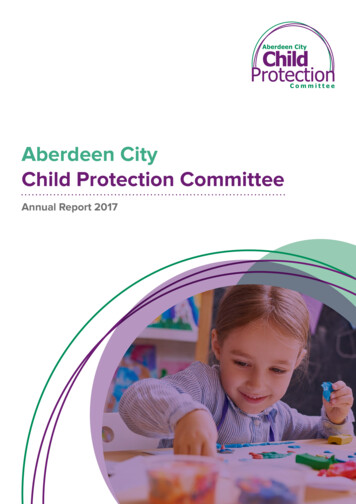
Transcription
Aberdeen CityChild Protection CommitteeAnnual Report 2017
Contentspage 2Preface from Chief Officers3Introduction to the Child Protection Committee4The Child Protection Programme6Child Protection Partnership14Performance Management16Financial Implications21Future Planning22Conclusion22Appendix: CPC Governance Structure23
Preface from Chief OfficersThis is the fourth Annual Report of Aberdeen City ChildProtection Committee. Ensuring that all children inAberdeen are safeguarded and protected from harmand abuse is taken very seriously by all involved. Thecommitment of all agencies is apparent in the day to daydelivery of child protection services. It can also be seenin those agencies’ extensive contribution to the strategicimprovements and developments carried out in 2016/17.Aberdeen City Child Protection Committee coversthe Aberdeen City local government area. The ChildProtection Committee works with child protectionagencies locally and nationally and, more widely, withcolleagues across Integrated Children’s Services in thisCity. It aims to support the multi-agency workforce andmembers of the public to ensure Aberdeen is the bestplace in Scotland to grow up, to promote the care andwelfare of our children and to protect them from abuseand harm.Angela Scott, Chief Executive,Aberdeen City CouncilWe are committed to partnership working to ensurethe protection and safety of the City’s children andyoung people. We are committed to understanding thechild protection concerns which arise in our City andto making improvements together to address these.The Child Protection Committee has representativesfrom social work, police, health, education, housing,Children’s Reporter and the third sector. Theirachievements are highlighted in this report and includework in the areas of child sexual exploitation, online safety, significant case reviews, the provision ofconsistent child protection services and making the bestuse of data.The work of the Child Protection Committee couldnot have been delivered without the commitmentand support of many practitioners. We thank them forthe contribution of their time, experience and insighttowards the safeguarding of our children and youngpeople.Chief Superintendent CampbellThomson, Police ScotlandMalcolm Wright, Chief ExecutiveNHS Grampianpage 3
Introduction to the Child Protection CommitteeWhat is the role of the Child Protection Committee?The Aberdeen City Child Protection Committee (CPC)is a locally based, interagency strategic partnershipresponsible for the design, development, publication,distribution, dissemination, implementation andevaluation of child protection policy and practice acrossAberdeen City.Child protection means preventing a child sufferingsignificant harm from abuse or neglect. The CPC iscommitted to its responsibility to keep all children inAberdeen City safe from that harm whether abuse orneglect has already taken place or looks likely to takeplace.In working to achieve that, the functions of the CPCare continuous improvement, strategic planning, publicinformation and communication. Professional and publicbodies work collaboratively to promote and improvechild protection across all areas of their agencies andservices.page 4Who are the members of the Child ProtectionCommittee?The CPC has a membership across the full rangeof agencies and services with child protectionresponsibility including Aberdeen City Council (includingsocial work, education and housing), Police Scotland,NHS Grampian, the Reporter to the Children’s Hearing,the Alcohol & Drugs Partnership, Aberdeen Violenceagainst Women Partnership and the third sector. TheCPC is chaired by Heather MacRae, Lead Nurse,Aberdeen City Community Health and vice-chaired byGraeme Simpson, Lead Service Manager, Education &Children’s Services, Aberdeen City Council. All membersaim to consistently improve upon the delivery of robustchild protection practices across the public, private andwider third sectors.
Who is responsible for and to the CPC?How does the CPC work?The National Guidance for Child Protection in Scotland2014, requires that each CPC be governed by a ChiefOfficer Group. The Local Police Commander and theChief Executives of NHS Grampian and AberdeenCity Council are the Chief Officers responsible for theleadership, direction and scrutiny of the local childprotection services and the Child Protection Committee.They have strategic responsibility for the CPC.The CPC now meets four times each year as well ashaving an annual development day. All the membershave child protection skills and knowledge. Theyconsider information from a variety of sources such asthe local Child Protection Register, Children’s Reporter,Aberdeen Alcohol and Drugs Partnership, significantcase reviews, formal inspections of Children’s Services,case file audits and national developments. Identifiedareas for improvement and emerging trends in relationto child protection are then incorporated into the ChildProtection Programme, of which, more in this report.Aberdeen City CPC, through its Operational SubCommittee, also fulfils the function of the Safe OutcomeGroup within the local Integrated Children’s Servicesstructure. This means that child protection is seenalongside the wider context of supporting families andmeeting children’s needs through Getting It Right ForEvery Child. GIRFEC is the national practice modelwhich aims to ensure children and young people aresafe, healthy, achieving, nurtured, active, respectedresponsible and included.Some areas of child protection activity are shared acrossAberdeen City, Aberdeenshire and Moray local authorityareas. These are delivered under the identity of theChild Protection Partnership. These activities are theChild Protection Register (CPR) and the delivery of childprotection learning and development opportunities tothe multi agency workforce, including Joint InvestigativeInterview training.The CPC also works in partnership with the ScottishGovernment and other CPC’s nationally to take forwardchild protection policy and practice across the local areaand across Scotland.The Operational Sub-Committee, which meets six timeseach year, has responsibility for delivering the multiagency Child Protection programme and reports directlyto the CPC.A professional group to drive on work in relation toChild Sexual Exploitation (CSE Sub Group) reports tothe Operational Sub Committee. It’s remit has beenextended in 2016 to also cover child trafficking, anemerging issue inextricably linked to CSE.A Significant Case Review Sub Committee wasestablished in late 2016 to progress any SCRs locallyand to ensure that the learning from SCRs around thecountry is disseminated in the Aberdeen City area.A Learning & Development Sub Committee will beestablished in 2018 as soon as a multi agency childprotection learning & development coordinator hasbeen appointed. This will identify and address the areaswhere multi agency child protection learning will benefitprofessional practice across the range of services inAberdeen City.The structure is illustrated in a diagram formingAppendix 1 to this report.page 5
The Child Protection ProgrammeWhat are the key themes of the Child Protectionprogramme?The Child Protection Programme (CP Programme) hasbeen developed and continues to evolve to ensure thatthe CPC functions are fulfilled. The core functions ofall Scottish Child Protection Committees are specifiedby the Scottish Government in national guidance ascontinuous improvement, strategic planning, publicinformation and communication. Those functions havebeen incorporated into the multi-agency CP Programme.There three key themes of the CP Programme arelinked to the Quality Indicators as outlined in the CareInspectorate document “How Well Are We Improving theLives of Children and Young People?”. These are How well are the lives of children and young peopleimproving? How well are partners working together to improvethe lives of children, young people and families? How good is the leadership and direction of servicesfor children and young people?How is the Child Protection Programme informed?In the CP Programme, we make sure national prioritiesare addressed as well as work required by localstrategic plans, such as the Children’s Services Planand the Local Outcome Improvement Plan (LOIP) whichrecognises that ‘Children Are Our Future’ and need tobe safe and responsible as well as protected from harm.We also incorporate other local work identified throughvarious self-evaluation strands such as case file auditing,significant case reviews, inspection findings, statistics,data analysis and practitioners knowledge. Theprogramme is reviewed at the annual CPC DevelopmentDay to which all members of the Chief Officers Group,CPC, Operational Sub Committee and any other relevantgroups are invited. The CPC has developed a RiskRegister in 2017 which is kept under review by both theCPC and the Chief Officer Group.page 6We have carefully considered and contributed tothe Scottish Government’s National Child ProtectionImprovement Programme (CPIP) which was initiated inMarch 2017. The key themes identified are the CPC governance structure and links with ChiefOfficer Groups the operation of Child Protection Registers and ChildProtection Case Conferences learning from Significant Case Reviews children’s and families’ experiences of the childprotection process.The current child protection programme hasconcentrated child sexual exploitation, on-line safety,significant case reviews, the provision of consistent childprotection services and making the best use of data.We are now building on that to include focus on childprotection and disability, neglect, child trafficking, femalegenital mutilation, forced marriage, and domestic abuse.The CPC is committed to improving links with otherpublic protection partnerships in the City such as theAdult Protection Committee, Violence against WomenPartnership and the Alcohol and Drugs Partnership;the work of all these other partnerships impacting onvulnerable children in the City.The CPC is also committed to the appointmentof a Learning and Development Coordinator andthe establishment of a Learning & DevelopmentSub Committee to ensure local training issues areaddressed and learning from significant case reviews isdisseminated.
What has the Child Protection Programme delivered in2017?There follows a flavour of some of the work carried outunder the programme throughout 2017.Making Best Use of Data Child Protection data including information fromthe Child Protection Register, ADP, SCRA and ChildProtection Case Conference Performance Report arereviewed and analysed at the CPC and OperationalSub Committee meetings. This enables us to reviewperformance, benchmark with other authorities,identify trends and areas for improvement. Weaim to continue to mature in the use we make ofmanagement and performance information. CPC has prepared a data and performanceframework for its areas of responsibility. Use of thisframework began in March 2016 and has been usedfor reporting to the CPC on the impact of the CPProgramme. An extensive multi agency case fileaudit in 2017 assisted in the identification of areas ofstrength and areas for improvement . The use of thedata framework and the finding of the multi agencycase file audit assisted the CPC in identifying thestrategic priorities for the new CP Programme. Our data framework has attracted some nationalinterest as it is an attempt to deal with the “so what?”elements of performance information. We are in theearly stages of work with CELCIS as they implementthe data and performance elements of the ScottishGovernment’s Improvement Programme.We are also leading on work through the Centraland North Consortium of CPCs to develop a simpledata framework which will provide a basic, butup to date, source of comparator child protectioninformation.page 7
Case File AuditingChild Sexual Exploitation and Child Trafficking The CPC and children’s social work completedan extensive audit in relation to current practicearound children going on and coming off the childprotection register. Full reports were presented andthe recommendations endorsed at the CPC meetingin June. The multi and single agency follow-up isreported to the CPC on a 6 monthly basis. There has been much emphasis on continuing localwork in relation to child sexual exploitation (CSE) andthe City has adopted a Zero Tolerance approach toCSE. The CSE sub group has been progressing localwork on CSE for the past 18 months and coordinatesthe multi agency response to CSE. This group hasbeen proactive in developing resources to ensurethat our practitioners are confident and competentin recognising and reporting signs and concerns ofCSE. Its remit has been extended to include ChildTrafficking as it increasing becomes apparent thatthis is closely linked to CSE. The group’s action planforms part of the CP Programme and focusses onthe national priorities of Prevention, Disruption &Prosecution and Recovery. Professional awarenesshas increased through training opportunities madeavailable through the Child Protection Partnership,national CSE working group and the UK SaferInternet Centre. CSE has been added as a categoryof concern and recording on CareFirst. The CSEgroup has produced and the CPC has endorsedthe “Strategy and Extended Guide to CSE forPractitioners” and the “Short Guide for Practitioners:Identifying CSE”, both of which have been widelycirculated to the multi agency workforce. On the back of the main findings of the audit, theCPC will now be progressing the following: Developing a strength based approach to ChildProtection. This will be in the Signs of Safety style.CaseConferences will be conducted using this approach. Improving documentation, report writing andwriting children’s plans and quality assuring these. A consistency of understanding of significantharm and its impact on the child across the multiagency workforce Developing options for reviewing a Case whichhas been on the CPR for more than 1 year.Child Protection Register A significant source of information about categoriesof concerns and emerging trends comes from themanagement information compiled by the CPR.This enables the CPC to consider issues in its owngeographical area and to compare trends acrossthe Grampian area. The annual figures are takenat 31 July each year and reported to the ScottishGovernment. The most recent figures from the CPRindicate that the predominant risk factors acrossAberdeen City remain domestic abuse, parental drugand alcohol misuse, emotional abuse and neglect,with increasing evidence of concerns aroundparental mental health.page 8
Aberdeen City hosted a north east CSE event inconjunction with Scottish Government in March2017. This event was hosted by the Child ProtectionPartnership and was aimed at multi agencycolleagues from Aberdeen City, Aberdeenshire andMoray child protection committees. Representativesattended from Police Scotland, NHS Grampian,Children’s Hearing Scotland, Crown Office &Procurator Fiscal Service (COPFS), the three localauthorities and the third sector. Presentations weregiven by Moira McKinnon, chair of the National ChildSexual Exploitation multi agency working group,Detective Superintendent Elaine Galbraith, DS forChild and Adult Protection within Police Scotland, DSLorna Ferguson and Sharon Ralph, Procurator FiscalDepute specialising in sexual crimes and crimesinvolving children. The event provided an overviewof national developments and an opportunity todiscuss implementation at a local level As CSE and child trafficking is everyone’s concern,the group recognised that we need innovative andcreative ways to engage with professionals andthe general public on this child protection issue.To coincide with the launch of the National HumanTrafficking and Exploitation Strategy, the groupcoordinated an awareness raising month in Octoberabout CSE and child trafficking, including thelaunch of the local practice guidance, a conferenceattended by 165 delegates, a Facebook live event inconjunction with the Police reaching 32,000 people,radio interview, and agency twitter and social mediacampaigns. The group along with Police Scotlandare, at the time of writing, distributing around 4800Z card leaflets on CSE and child trafficking to hotels,pubs, door staff, convenience stores, taxi drivers andschools. Aberdeen City have been fortunate to have one oftwo national CSE advisers; employed by Barnardo’sand funded by Comic Relief. The progress madeby the hard-working CSE and Child Traffickingsub group has been greatly enhanced by thecontributions of the CSE Adviser and the Green LightProject, who work with young people experiencingor at risk of CSE.Internet Safety The Scottish Government funded an event oninternet safety and child protection which was heldin Aberdeen in November and attracted 53 multiagency delegates.page 9
Child Protection Materials The web site/ pages for the CPC continue tobe developed to provide relevant, up to dateinformation in relation to child protection. Thewebsite can be visited at www.aberdeencity.gov.uk/childprotection National materials are endorsed such as those on theNational Risk Framework, Female Genital Mutilation,Forced Marriage and Human Trafficking. The GIRFEC national practice model and riskassessment framework brings together a range ofresources such as chronologies, genograms andecomaps. The CPC has endorsed these materialsfor use by staff across agencies and services in theAberdeen City area. Materials are available on theCPC web pages. As well as updated child protection informationforming part of the induction module for all staff atACC, there is an accessible on-line training moduleon GIRFEC and Child Protection for the Children’sServices workforce. All staff (old and new) havebeen encouraged to complete this. This module isintended for the general workforce. The experiencedchildren’s workforce staff will find this to be at basiclevel but may find it to be a useful refresher.page 10 Child Protection Case Conference documentationand guidance has been and continues to berefreshed. The Improvement Methodology wasused to obtain feedback from those participating inchild protection case conferences over an 8 monthperiod. The results indicated that alternatives meansof getting feedback and promoting participationwas necessary and fresh efforts are being made inthe new CP Programme. We are actively pursuingadopting a “strength-based” approach (in the Signsof Safety style), which is aligned with the aims of boththe LOIP and the national CPIP. Multi Agency Practice Guidance has recently beenrefreshed and has been launched: Working with Vulnerable Babies and their Families Working with Sexually Active Young People Working with Non Engaging Families Working with Families with problematic drug andalcohol use Working with Young People demonstratingSexually Harmful BehaviourThese sit alongside our CSE Strategy and ExtendedGuide and our Short Guide to CSE. A series of short guides have been prepared andcover Child Trafficking, Female Genital Mutilation,Forced Marriage, On line Safety, New PsychoactiveSubstances (“legal highs”), Domestic Violence,Grooming and Neglect
Learning and DevelopmentSignificant Case Reviews In the absence of a multi-agency training coordinator,learning and development opportunities havebeen made available through the Child ProtectionPartnership and national initiatives. Events havebeen held to raise awareness about child sexualexploitation, child protection and disability, significantcase reviews, and domestic abuse. Efforts to appointa multi-agency learning and development coordinator in 2017 proved unfruitful, but have beenreinitiated as at the time of writing. The SCR sub committee was established in 2016 andhas developed local procedures in relation to Initialand Significant Case reviews. The Local OperatingProcedure takes account of national guidance,Ministerial expectations and the procedures utilisedin our neighbouring local authority areas to ensureconsistency in approach. These will ensure welearn lessons locally from Initial and Significant casereviews as well as learning from SCRs conducted inother parts of the country. The post holder will deliver and commission a rangeof child protection training and will lead on anySignificant Case Reviews from which much learning isgleaned. This programme of learning will be availableto all multi agency children’s workforce includingall members of COG, CPC and sub committees.The CPC is in process of establishing a Learning &Development Sub Committee in support of this work An SCR development session was held in March.This event was aimed at Child Protection Committeeand Significant Case Review sub-group membersand 32 members were in attendance from City,Shire and Moray CPCs. The development sessionwas led by Beth Smith and Jane Scott, independentconsultants with experience leading SCRs inScotland. This remains an area of risk as the post hasnot yet been filled and the gap in multi-agencychild protection training is notable. Continuousimprovement, including training and staffdevelopment, is one of the 3 key functions of theCPC. Further, the post holder will be responsible forthe progress of and learning from ICRs and SCRswhich is an area of intense activity and scrutiny. In 2017, the SCR sub committee has producedLearning Reviews for all agencies following a localInitial Case Review and three SCRs conducted byFife CPC. These have been reported to the CPC andChief Officer Group. The various child protectionagencies in Aberdeen City are responsible workingtogether or individually to ensure the findings areprogressed and for reporting to the CPC. Responsesand improvements will be monitored by the CPC and,in turn, reported to the COG. A further two local ICRs are currently underway. This has in short timescale become a very busy,hardworking and effective sub committee. Referralshave been received from social work, police andhealth which would indicate a broad understandingof the procedures now in place and a healthyapproach to learning from significant incidents.page 11
Development Day 2017Child Protection and Domestic Abuse All COG, CPC and sub committee members wereinvited to the CPC development session in April. Thefocus was on - Practice Guidance on child protection anddomestic abuse is being developed through ashort life working group led by CPC member and inconjunction with Grampian Women’s Aid. It will bebased on the Scottish Government “Equally Safe”Strategy. The issue of the guidance will be followedup with local (Aberdeen) awareness raising andmonitoring of use and impact of the Equally Safeapproach. Scottish Government Child Protection ImprovementProgramme (CPIP) - The Scottish GovernmentReports on these matters were carefully consideredat the development day and all relevant local mattershave been incorporated into the ongoing CPC childprotection programme.Neglect - work is being progressed as a strategicmulti agency starting point.Data - Development of data analysis and reportingwill continue to be taken forward.Learning & Development - ideas for modern,economical and effective dissemination of learningwere explored and will be further advanced onappointment of the Learning & Developmentcoordinator.Vulnerable 16 - 17 year olds Adult and children’s services across multi agenciesare working on protocol in relation to vulnerable 16-18year olds. Clear guidance on Child/Adult protectionis already in place – this new work is about theembedding of a GIRFEC approach in relation tothose young people not hitting that criteria but whowe know are about to disappear off the school radar,keep running away from home or residential unit,are about to be thrown out at home, have beenattending STD clinics etc. This is consistent with theexpectations of the Scottish Government’s CPIP.page 12 The CPC hosted a conference in November 2017on child protection and domestic abuse, which wasattended by 170 delegates, and had national andlocal speakers including Dr Marsha Scott of ScottishWomen’s Aid.
Strength - Based PracticeNeglect Consistent with the CPIP aims, we aim to adopt astrength based practice approach across all agenciesand services in Aberdeen City. The children’ssocial work model, Reclaiming Social Work alreadyincorporates this style of working with vulnerablefamilies. Evidence from other parts of Scotland, UKand world-wide indicates that outcomes improvefor children and families through such an approach.Work has commenced on a small scale utilising theImprovement Methodology to implement a strengthbased “Signs of Safety” style to improve on childrenand families participation in the CP process. This is one of the areas of focus of the local childprotection improvement programme. It should benoted that neglect is a broad issue straddling a rangeof multi and single agency services, particularlythose with a focus on earlier intervention. The CPCfocus is in relation to child protection and neglectand it has established 2 sub-groups to start off onthis work. The first will pull together a Neglect multiagency strategy and guide. The second short lifegroup will consider a sample of the Plans for childrenon the CPR for neglect. It will use them as a measureof whether the current planning to address neglecthas a consistency, and whether the current planningresults in the reduction of the risk of significant harmdue to the neglectpage 13
Child Protection PartnershipAberdeen City CPC participates in the joint activitiesof the Child Protection Partnership. The three separateCPCs for Aberdeen City, Aberdeenshire and Morayhave worked together under the banner of the ChildProtection Partnership in relation to the Child ProtectionRegister, Joint Investigative Interview training and somebespoke child protection training, such as conferences.As well as a resource for professional staff acrossagencies, valuable management information is drawnfrom the Child Protection Register and, as part of theCPC’s self-evaluation activity, assists in the identificationof emerging gaps and trends.From 2017 onwards, training (other than jointinvestigative interview training) will be a local CPCresponsibility.ConferencesThe Partnership, works with The Robert GordonUniversity in the coordination and hosting of miniconferences. In June we hosted a Child Protectionand Disability event, with Dr Audrey Cameron fromEdinburgh University speaking, through a translator, toan audience of over a hundred attendees. The eventhas been highly evaluated. This often overlookedaspect of child protection forms part of the local ChildProtection Programme. Useful national materials areavailable and will be an area of prioritisation for the L&DCoordinator once in post.The conference held in November 2017 focussedon child protection and domestic abuse, which wasattended by 170 delegates, and had national and localspeakers including Dr Marsha Scott of Scottish Women’sAid. In January 2018, the child trafficking event, whichhad been postponed from September, was held andattracted 165 delegates from a range of disciplines.page 14Joint Investigative Interview trainingJoint Investigative Interview training is coordinatedalong with Police Scotland and ensures that selectstaff in police and social work are adequately trainedto deliver this essential element of child protectionin Aberdeen City. Coordination meetings are heldquarterly. The annual business meeting in relation tolocal arrangements will be held in February 2018.
Child Protection RegisterThe risk of abuse or neglect will be considered at aChild Protection Case Conference. Where a child isbelieved to be at risk of significant harm from abuse orneglect, their name will be added to the child protectionregister (CPR). The register enables agencies to beaware of the children at greatest risk in this area and tothen plan to minimise those risks appropriately.Statistical information from the CPR is intimated to theScottish Government, annually with figures as at 31 July.Useful management information flowing from the CPRis produced by the Child Protection Partnership officeand assists in informing the CP Programme. The formatof the report from the CPR containing managementinformation from the Child Protection Register has beenrefined and will continue to be reviewed to assist theCPC and to inform the CP Programme.Some more detailed performance managementinformation is considered below. This information hasbeen drawn from the CPR.The areas of concern are identified at a caseconference and recorded on the CPR. These can beone or more of the following in the table below:1.neglect2.parental substance misuse3.parental mental health problems4.non-engaging family5.domestic abuse6.sexual abuse7.physical abuse8.emotional abuse9.child placing themselves at risk10. child exploitation (not current)child sexual exploitation12.11.child traffickingpage 15
Performance ManagementThe suite of performance management information nowrequired by Aberdeen City CPC includes the following;comprehensive quarterly reports from the ChildProtection Register, SCRA Child Protection Committeereports, numbers of Child Protection Orders from LegalServices, Alcohol and Drugs Quarterly reports andadministrative information from Child Protection Admin(Aberdeen City Council). These reports are consideredat each meeting of the Operational Sub-Committee andreported upon, in accordance with the data framework,to the CPC. Performance issues arising are addressedas appropriate. The CPC aims to continue to developthis work through digitalisation. It is aware of the benefitsof collaboration with Integrated Children’s Services,particularly in demonstrating outcomes sought by theLOIP.A significant source of information about categoriesof concerns and emerging trends comes from themanagement information compiled by the CP
the Child Protection Register, ADP, SCRA and Child Protection Case Conference Performance Report are reviewed and analysed at the CPC and Operational Sub Committee meetings. This enables us to review performance, benchmark with other authorities, identify trends and areas for improvement. We aim to continue to mature in the use we make of

